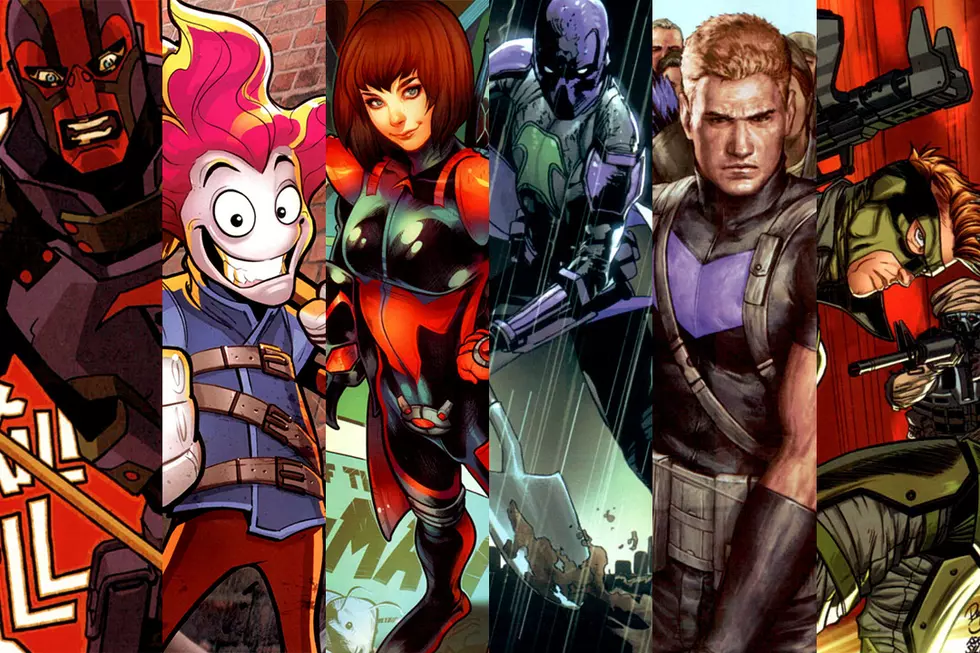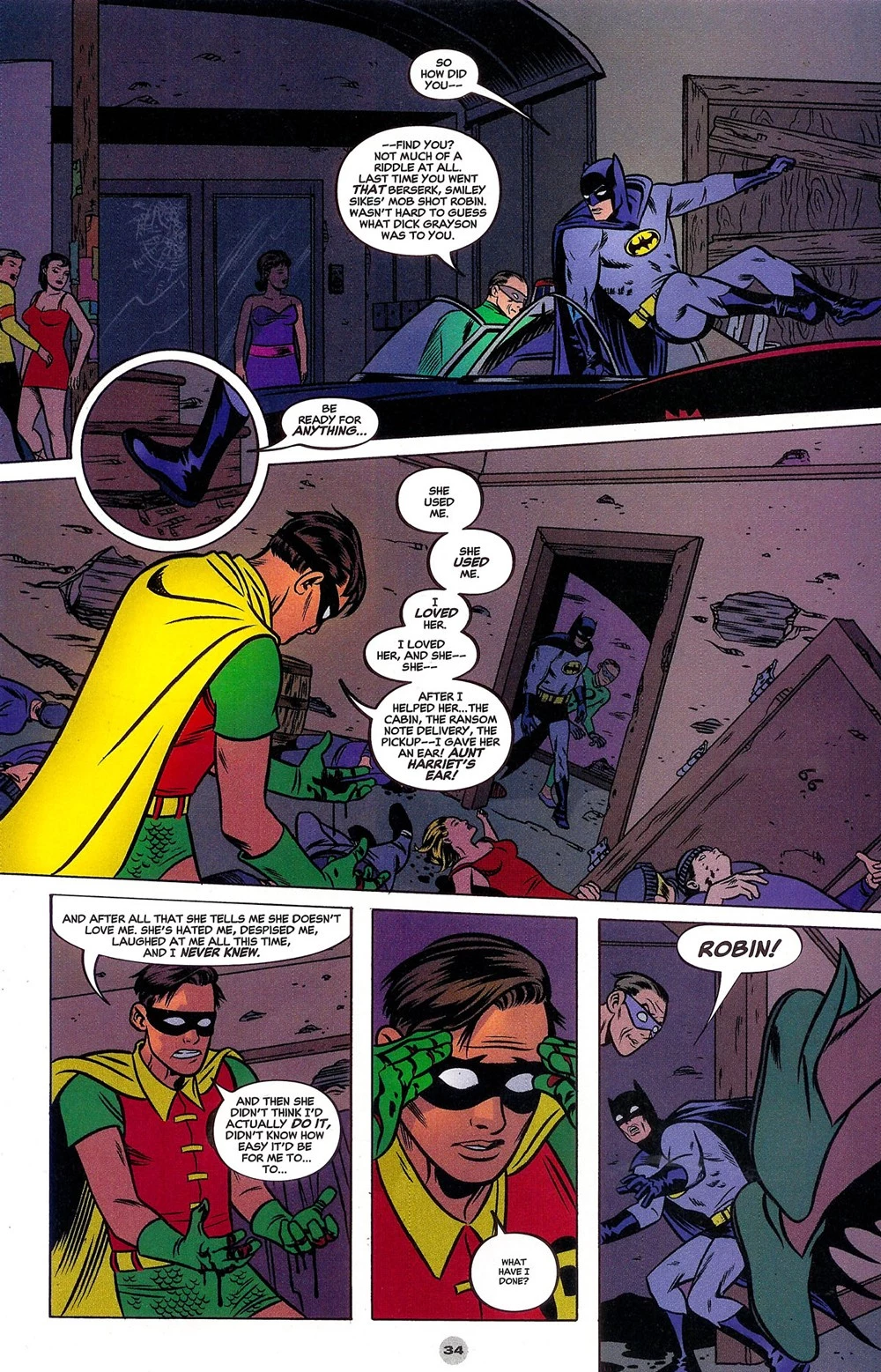
Duet On ‘Solo’, Part Seven: Michael Allred

Published between 2004 and 2006, Solo was a DC Comics anthology series with an innovative twist: each issue was created from the ground up by a single cartoonist and collaborators of his own choosing. Edited by DC's head art director Mark Chiarello (Wednesday Comics, DC: The New Frontier), the series offered artists a platform to control their visions completely in the form of original stories, unfettered access to DC's library of characters, and without regard to continuity or other publishing concerns that affect the creation of a typical DC superhero book. Although Solo spotlighted the work of such talented and popular creators as Darwyn Cooke, Tim Sale, Paul Pope and Michael Allred, the series was cancelled after just 12 issues.
Even in a time when the superhero comics were experimenting wildly with structure and style, Solo stood apart and remains one of the best and most interesting mainstream series to emerge from the early years of this century. In this installment of Duet on Solo, writers Sean Witzke and Matt Seneca take an extremely close look at the seventh issue of Solo, created by Michael Allred.Matt Seneca: The second half of Solo's run kicks off with the pop-comics stylings of Mike Allred. The issue is both an appropriate prelude to what would follow, and a bit of an anomaly. The first six issues of Solo mostly saw a group of quirkier mainstream artists -- all but one of them dudes who had or have since done a good deal of work on DC superhero comics -- trying to figure out how to balance their broadly appealing tendencies with more personally expressive storytelling. The final six, on the other hand, was a group of more iconoclastic fringe cartoonists -- only one of whom ever had an extended run on a mainline DC book -- basically telling an ever-winnowing group of discerning readers what we already knew: if you want to make innovative, challenging comics, it's probably best that they don't feature moldering action figures as protagonists.
Sean Witzke: Which makes this issue all the odder because it is the most pro-superhero issue of Solo, not simply starring superheroes but Allred even calls it a love letter to '60s DC comics, Teen Titans, Doom Patrol, New Gods, and the Adam West era of Batman. He never drew anything as close to the great Bruno Premiani as he does here. And more than that, the coloring, the dialog -- this is Silver Age DC/the DC of Allred's childhood being reflected back in a short, solid primary color blast.
MS: What's your mileage on the Silver Age DC stuff? I love it more than just about any other superhero comics, but I know a large segment of mainstream comics fans find it too goofy, too whimsical, too abstruse. I think that polarized fan community view on the material is important to note, because this issue, as much as it's an openhearted cri-de-coeur to superheroes, is also the beginning of a more rigorous curation process by the Solo artists. In the first six issues it felt like the dominant tone was "I'll see what it's like to draw at DC now," but starting with Allred's issue there's a much greater focus on isolating what each artist likes about the company they're doing work for, and then amplifying it.
SW: I haven't really read much of the Silver Age DC comics outside of a few odd, classic Batman and Superman books. Growing up, the Silver Age stuff I was exposed to was Marvel for the most part -- Wally Wood Daredevil and Kirby. But I actually really love the Bruno Premiani Doom Patrol comics of that era, and The Challengers of the Unknown. Those are some of the most exciting comics that have ever been published by either of the big two houses. I am an enormous Adam West Batman fan, though.

MS: You can see a whole era of comics and pop culture being distilled in Allred's art -- Wood inking Kirby on Challengers, Premiani, a lot of Dick Sprang Batman and Curt Swan Superman, and an art student's knowledge of Roy Lichtenstein. It's the zeitgeist of what Stan Lee called "pop art productions" boiled down into one solid drawing style. I've always admired how well Allred's art evokes the Silver Age without falling into the mile-wide pit of obvious Kirbyism. He seemingly owes the same amount to everyone whose pen touched paper on a pre-Neal Adams hero book in the '60s.
SW: Allred kind of steals back some of the Lichtenstein imagery in a really interesting way, here. It's also really amazing at highlighting the non-Marvel aspects of the Silver age you see in Allred's art. There's a lot of Kirby, Premiani, Ditko, and the Hernandez brothers in Allred's Madman, but he dials all that back to a more lush, clear style. And then the material he and his collaborators (basically his family) choose to tell stories about is as much a part of that without ever feeling like "Oh, dumb Silver Age" potshots, the way even Alan Moore's love letters to the era tend to be blinkered.
MS: If anything, I think the potshots being taken are at Moore and company, the prime movers of superhero comics' turn away from childish fun to gritty seriousness.
SW: I've always said that "Batman-A-Go-Go" being published at the same time as Grant Morrison's dire and ugly Batman R.I.P. arc was incredibly just criticism of everything that arc represented the culmination of.
MS: The comic I always tend to compare "Batman A-Go-Go" -- the 20-page main attraction of this issue -- with is Josh Simmons' bootleg Batman minicomic, which operates on the other end of the dark-light spectrum in order to make a similar point. Both are basically asking the question of when the "realist" Batman of the post-Dark Knight Returns era is going to confront the fact that actual, senseless horror much greater than any supervillain's handiwork exists in the world. But where Simmons makes Batman a part of that horror, Allred pulls back, still finding enough light in the concept of the superhero to turn back at the edge of the abyss. It's full of Miller parody: Batman recoils in horror at the thought of "slicing hands with razor-sharp little batarangs," and Alfred (the TV version) pulls out the same Nietzsche quote Alan Moore does at the end of the Rorschach chapter in Watchmen -- not as a condemnation of the human soul, but an affirmation of its potential for goodness. It's a bravura performance, just as sophisticated, intertextual, and thought-provoking as Moore and Miller's "gritty" comics without ever sinking to what Allred clearly sees as their much lower level.
Click images to enlarge
SW: It is telling that the Simmons story and "Batman A-Go-Go" are probably the two best Batman stories since the '80s. It also makes the distinction of the non-yellow-circle Bat-outfit as being "innocent" Batman and the yellow circle being Batman out of his depth. Which is great because it posits the change of the character's world at the same time as Batman became a media property first, and the comics were then aligned with the TV show. And now, in the era of Christopher Nolan and Tim Burton, the media are being manipulated towards the darker comics, which were ironically (and circularly) changed to react against the TV show. Bringing Adam West, Burt Ward, and Frank Gorshin into the realities of Moore and Miller (and Neal Adams) is the perfect weapon to point out that these characters are more perfect for stories for children than real-life politics informed dankness.
MS: Yeah, and also that they've been successful media properties as such. The work Allred does in this comic is so positive that it feels disingenuous to call this kind of storytelling "Moore-bashing" or whatever, but that strain of criticism informs the rest of the stories. Their childlike goofiness and retro kitsch comes off not just as nostalgia but active defiance. That story elevates its surroundings in addition to just being a great comic.
SW: Well, it's polemic comics, which is exactly what the Moore and Miller comics were, and it is pretty damn great to read any comic coming out of DC even in this era (half a decade ago) that is willing to take a stand on anything without being a copy of those ideas Miller and Moore ditched out on for greener pastures.
MS: Or preaching to the fanboy choir. Just as didactic, and almost as great a read, is the book's opening story, "An Hour With Hourman." If "Batman A-Go-Go" is Allred taking Dark Knight Returns and Killing Joke head-on, this is his Watchmen-parodying tour-de-force. Everything from the black backgrounded block letters of the opening title to the nine-panel grid the story leans on and plays around inside is not just directly jacked from but meant to call up readers' memories of Watchmen.
SW: Which is so great because it takes the same sensibility of colliding real world with Silver Age, but it is so deft and light. It's so funny.

MS: And that's an important thing, because the stuff Allred is making light of here -- high formalist comics, drug fiend superheroes -- has been the stuff of much less entertaining, much less interesting comics. The key to making those things work as comedy is just Allred's skill with the medium. The gags remain sharp through all 60 panels of Hourman's 60-minute superhero high (what do you do when there's no fires to put out? Mess up a pickup basketball game and then watch some cartoons, just like real junkies do!), and when the comic finally explodes into a panel or three of action, it's both perfectly drawn and a release of some expertly built tension. The fact that Allred's goofy one-note-joke story ends up beating Moore and Gibbons at their own formalist game -- a panel for every minute of story time, done so fluidly that you don't even notice -- is just the cherry on top.
SW: And funny isn't something that is at all easy to do, it's all about really small sophisticated uses of timing and gesture. And of course like anyone on uppers, Hourman ends up spending the last page in the mirror in the bathroom and playing with his bellybutton. That's just perfect three-panel satire. Also incredibly important: if you don't get the Watchmen gag it is still very funny, just like the Batman story. It still functions as a Batman story, these aren't in-jokes and they aren't reliant on reader knowledge, they're layered stories that deliver.
MS: The subtlety of Allred's humor is probably best seen in the "Teen Titans vs. Doom Patrol" story that comes in between those two. It's an incredibly basic thing, probably the most directly similar to actual '60s superhero comics of anything in this issue -- the two titular super-teams end up butting heads after the Titans' wild sock hop gets out of control. But there's no end of winking, modern-era humor in the dialogue, which jabs elbows at Bruce Wayne's possible alcoholism and homosexuality, fondly lampoons the random, illogical plot twists of Silver Age fights, and makes obvious reference to the undercurrent of extreme sexual frustration running rampant through teen-superhero comics. It's 2005, so we can finally acknowledge that all those dudes just started the team because they really wanted to bang Wonder Girl. And yet the story comes across -- once more, largely due to Allred's art -- as sweet and charming, rather than pervy or overly knowing.
SW: It's fantastically faithful, too. There's not any of the Brad Meltzer bad-touching of the continuity even as he does all of that, even with the Mon-El time travel bit and the Legion of Super-Pets, and Vic Steele getting angry for no reason all the time, Aqualad's terrible ticking clock superpowers. And the band which I know is in-continuity of something but I couldn't tell you what. What could be toned wrong and just a loud Silver Age tribute is instead playful with its subject matter. Like the Hourman story there's a lot more skill than you'd think to do something like this. BOBBY SHERMAN! BOB-BY SHER-MAN!

MS: I tend to think that there's a bit of a drop-off in this comic after those three stories -- it feels to me as though somebody broke the news that Solo was a 48-page comic, not a 32-page one, to Mike Allred a little too late. The rest of the issue's still beautifully drawn, but starting with the two-page "Fourth World Wager," a cute New Gods thing, it starts to feel a bit like the real meat of the first three stories is gone. I mean, why even bother with a two-page story, especially if it's superheroes and not the size of that one big Kramers Ergot?
SW: The New Gods story isn't great. You get the feeling that it is the only thing here that can be called filler. Allred might have just wanted to take the chance to draw these characters, even though the New Gods are kind of well out of the era of the rest of the material Allred is so lovingly dedicating this issue to. It also might have been a replacement for something else -- there was a kind-of public series of problems with editorial revoking the covers to this comic multiple times. We don't know how much they changed on the interior. Allred's original cover (which is now on the back of the issue) was a straight-up homage to DC Showcase, which was rejected. Then Allred had a cover of the clearly Adam West Batman doing the Bat-tusi, which was then spiked because DC prefers to minimize any and all reference to the Adam West Batman show. Probably because of rights issues, too. Fox owns the TV series. But also because since Frank Miller, there's been a level of shame about Batman's association with the show. I'm surprised that the interior story survived. And then Allred just handed in several characters all doing the Bat-tusi and we ended up with Wonder Girl. Allred draws a great Wonder Girl, so who is complaining? But it does show that there was an editorial hand even in this book, which was all about editorial being hands off.
MS: I like to see that cover, and Allred's insistence on the Bat-tusi, as a double, British Invasion-style "eff you guys" to editorial!
SW: IT WAS GOOD ENOUGH FOR TRAVOLTA, DAMNIT!

MS: So what do we think of the final, silent piece, a bit of semi-autobiography called "Comic Book Clubhouse?" It suffers from the same cutesiness that marred just about all of the autobio stuff in Solo, but the lack of words and the straightforward, almost deadpan presentation of superheroes hangin' around the real world has a pretty enjoyable surrealism to it.
SW: I think it is really sweet, heartfelt, and gorgeous. But it is pretty long, right? I do like it a lot more than almost all of the self-insertion comics in Solo, except for Aragones' piece.
MS: Well, we can talk about Brendan McCarthy's self-insertion methods (AHEM) when the time comes. But yeah, beautifully drawn, like the rest of the issue. The double-page splash featuring about a billion DC heroes both obscure and world-renowned is a fantastic drawing no matter how you look at it.
SW: It is pretty great that the kids defeat the Mad Mod by cutting his hair. That's the most Allred thing in this whole issue. But yeah, more fun for the vista of heroes. I do think that Allred really opens up the format with this issue, though -- from here on out these are personal letters to the medium/DC Comics/the reader/whatever. Personal letters to something.
MS: Yeah, the out-and-out format of it is pretty much the same as previous issues, a few shorts of differing length with some kind of a framing device, but it's the consistency and focus of Allred's issue that really spells the change. All the Solo issues previous are about artists stretching out, trying to cover all the tonal ground their careers in superhero comics have prevented them from ever visiting, whereas Allred searched out a territory that he can own outright and goes about claiming it.
SW: Allred's the most emotionally naked contributor so far, as well. You can't really discuss this issue without using words like "love" and "heartfelt," and you really feel that in the pages, which is something that never happens in a comic like this, or it does on a much shallower level anyway. I wish they were all like this.
More From ComicsAlliance
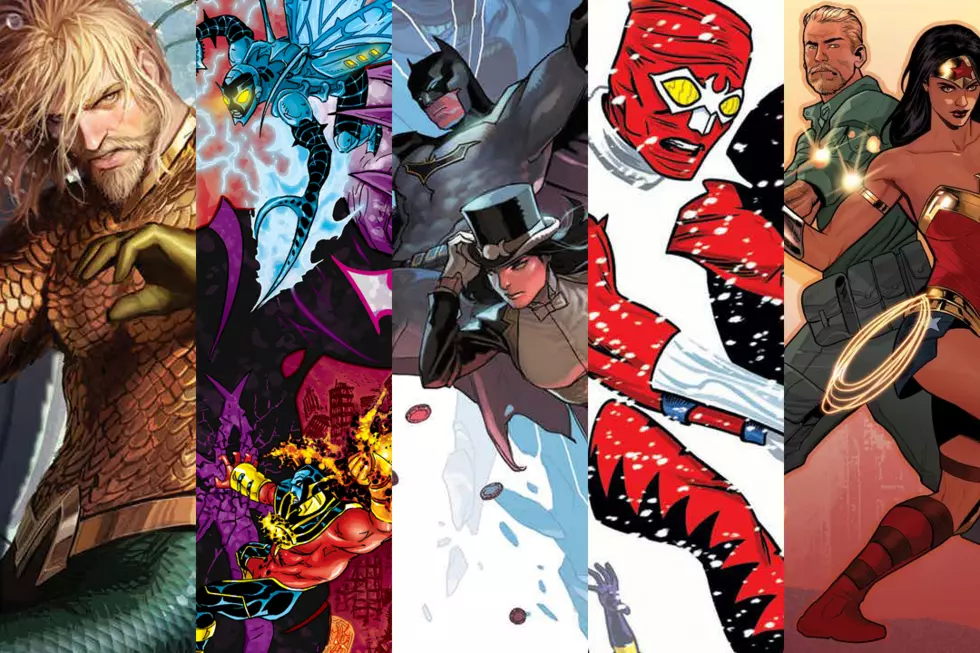
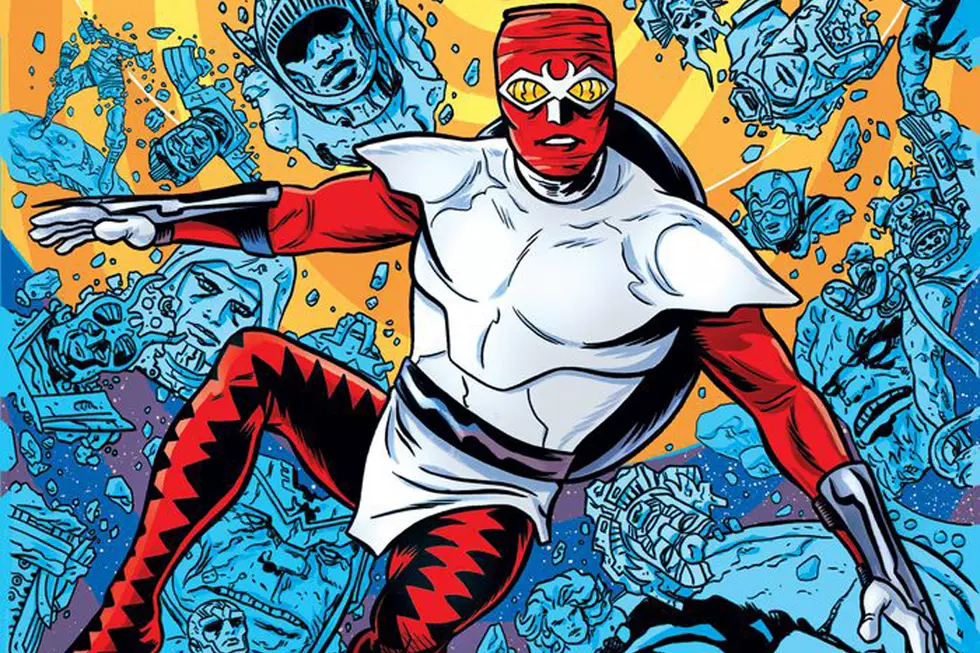
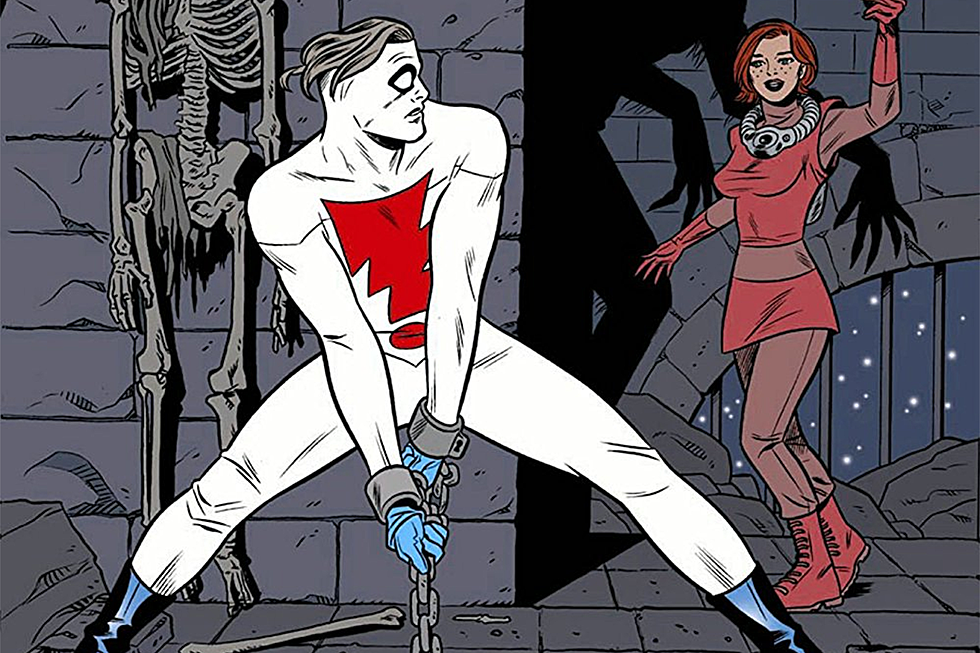
![Two Iconic Heroes Meet For The First Time In ‘Batman ’66 Meets Wonder Woman ’77′ #1 [NYCC 2016]](http://townsquare.media/site/622/files/2016/10/BMWW.jpg?w=980&q=75)
![Solo Is Not Necessarily The Best There Is At What He Does In New ‘Solo’ Series [Preview]](http://townsquare.media/site/622/files/2016/09/Solo_1_Featured.jpg?w=980&q=75)
![Meet The Boy Who Painted Death In Simon And Davis’ ‘Art Ops’ #11 [Exclusive Preview]](http://townsquare.media/site/622/files/2016/08/Art-Ops-Feat.png?w=980&q=75)


